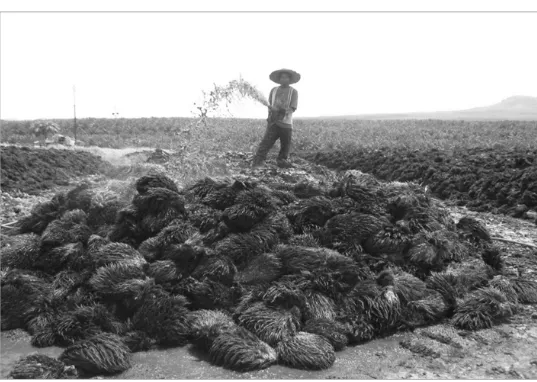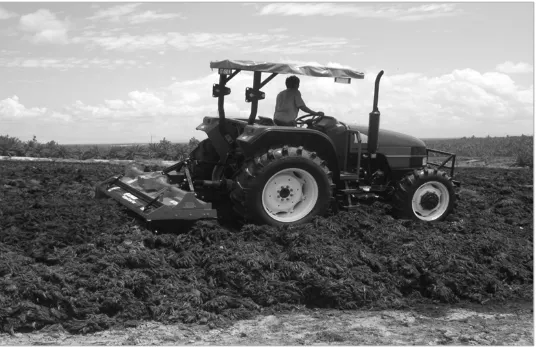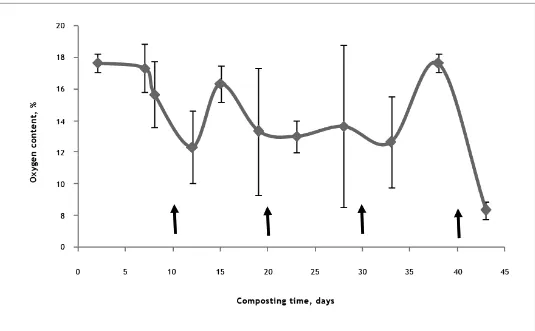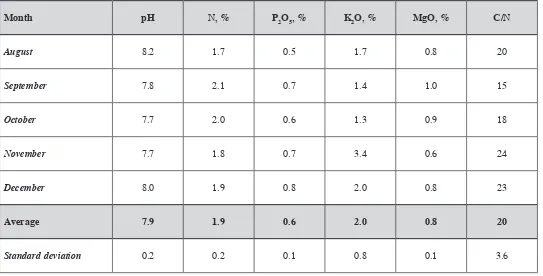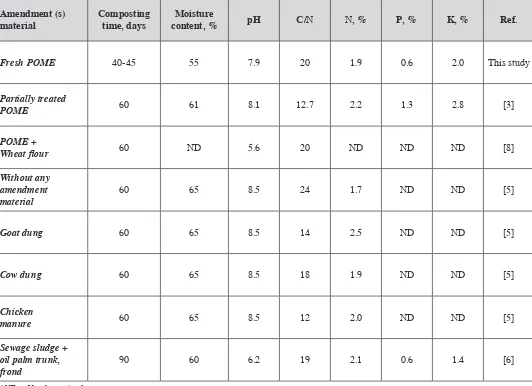Prestige Central Management Sdn. Bhd,
77B, Jalan SS 21/37 Damansara Utama, 47400 Petaling Jaya, Selangor E-mail: 1[email protected]
abstract
Composting of the empty fruit bunch (EFB) with the palm oil mill effluent (POME) could simultaneously treat the solid and liquid waste from palm oil mill. With the aim to reduce the composting yard area, production of semi-compost in industrial scale windrow was studied. Total composting time including preparation of the windrow was about 40-45 days and the windrow was turned every ten days. Compost quality; moisture content, pH, nitrogen and other nutrients, was evaluated during six months operations, and it was found that the nutrient in compost is acceptable for soil conditioner.
Keywords: Compost, Empty Fruit Bunch, Palm Oil Mill Effluent, Windrow
1.0 introduction
Palm oil industry significantly contributes to the economic growth in Malaysia. However, the palm oil mill produces a high amount of solid and liquid waste such as the empty fruit bunch, kernel, and POME (palm oil mill effluent) that requires treatment and disposal [1]. Composting is regarded as sustainable technology for processing solid and liquid waste from the palm oil mill [1-2]. Composting is a controlled biological process that can accelerate the conversion of organic matter to humic substances known as compost. The compost can be applied as a soil amendment or mulching [2]. The quality of compost depends on the raw material, process system, process parameter i.e. carbon to nitrogen ratio (C/N), moisture, turning frequency, etc. [2] as well as weather/season [3].
Several studies have been conducted for the empty fruit bunch (EFB). Enhancement of the composting process can be achieved by adding amendment material(s) such as animal waste [4-5] and palm oil mill effluent [3]. Applying POME as amendment material can be considered advantageous because it can reduce the total flow of POME to the wastewater treatment plant.
Effective EFB composting could reduce approximately 50% of the volume and hence the transportation cost [1]. However,
lengthy period for composting of EFB poses problems in the industrial scale composting due to high land area needed. It is reported that the composting system take about 50-90 days to mature depending on the raw compost mixture, system used and composting environment [3-6].
In conventional method, the purpose of shredding EFB is to increase the rate of biodegradation [3-5]. However, the shredding process is time consuming, use high electricity [4] and the important nutrient might be loss during the process. Moreover, it has been reported that the addition of POME onto the shredded EFB is troublesome because the liquid waste can easily leached from the heap [4]. The conventional process flow is shown in Figure 1.
2.0 methodoLogy
2.1 Production of compost at the merotai
composting Plant
Merotai Composting Plant is located at Tawau, Sabah, Malaysia and operating since April 2006. The plant was designed to process about 340 000 metric ton POME/year (60% from total POME) and 78 000 metric ton empty fruit bunch/ year.
The plant consists of a composting yard (4.0 hectares), palm oil mill effluent (POME) holding pond (1.8 hectares) and environmental pond (0.85 hectares). The system employed here is open turned windrow with size of 4 m length, 1.5 m height, and width 40 m. Each windrow contains about 120 metric ton of EFB and 324 metric ton POME respectively.
After the inoculation with the bacteria, the fresh EFB then was sprayed with POME (Figure 2). Then the composting Figure 1: conventional empty fruit bunch (EFb) composting
Figure 2: POME spraying into the empty fruit bunch
3.0 reSuLtS And diScuSSionS
Typical temperature and oxygen content were shown in Figures 4 and 5 respectively. Temperature in the windrow rose immediately (>53 ºC) during two days of composting (Figure 4) and then drop to temperature below 50 ºC. Turning process then increase the temperature back to greater than 50 ºC (~60 ºC) at day 11. Temperature approximately 50 ºC is essential to maximise biodegradation but temperature above 60 ºC has been reported to reduce the microbial activity [2]. From day 10 to day 25, the temperature was maintained at about 45 to 55 ºC with the aids of turning at the day 20. After the temperature starts to decrease, turning at day 30 again increase the temperature to ~50 ºC. However, at day 40, turning did not increase the temperature. process commenced and the compost windrow was turned using
the macerator to homogenise the compost as well as to enhance the aeration (Figure 3). The turning process takes place at day 10, 20, 30 and 40. Total composting process including windrow building and curing takes about 40-45 days. The compost then was applied at the palm oil plantation as soil amendment. The application rate is approximately 12 metric ton/hectares.
Sampling was taken in nine various points at each windrow and sent to the lab for analysis. Data on the composting temperature, moisture content, and nutrient analysis was generously given by the Prestige Central Management Sdn. Bhd.. Typical characteristic of empty fruit bunch (EFB) and POME are shown in the Table 1.
Figure 3: Empty fruit bunch-POME compost turning using tractor with macerator
(courtesy of Prestige central Management sdn. bhd.)
moisture, %
% on dry
n P2o5 K2o mgo
efB 58-65 1.1-1.2 0.05-2.6 2.4-2.7 0.4-0.5
Pome 96 0.08 0.08 1.2 1.5
Figure 4: typical temperature evolution for EFb-POME composting. arrow indicates turning. ambient temperature: 32 ºc. the bars on the
figure refer to standard deviation. (Average data on three windrows)
Figure 5: Typical oxygen content evolution for EFB-POME composting. The bars on the figure refer to standard deviation. Arrow indicates
October 7.7 2.0 0.6 1.3 0.9 18
November 7.7 1.8 0.7 3.4 0.6 24
December 8.0 1.9 0.8 2.0 0.8 23
Average 7.9 1.9 0.6 2.0 0.8 20
standard deviation 0.2 0.2 0.1 0.8 0.1 3.6
This is due to lack of carbon that has been fully utilised by the microorganisms and consequently, reduce the metabolism [2].
Oxygen is used as terminal electron acceptor for aerobic respiration and also in the oxidation of organic substance i.e. protein, cellulose, oil, lignin, etc. in the compost windrow. Therefore, the oxygen content is a critical variable to be controlled. In windrow composting, turning frequency is also an important factor for controlling the oxygen content. From Figure 5, the oxygen content is maintained above 10%, which is necessary for maximum biodegradation [3] although 5% oxygen content is reported to be sufficient for windrow composting [7]. At the later stage, lower oxygen content was observed. This incident might be due to the inefficient mixing. In general, this study shows that turning frequency for every ten days is adequate to supply enough oxygen for the EFB-POME compost pile. It has been reported that an optimum turning frequency was important in order to maintain the high temperature, minimise the nutrient losses/ pathogen and control the odour from the composting process [2, 7].
The turning frequency is different from one system to another depending on the substrate(s). Turning frequency of three days during composting POME-shredded EFB was reported by Baharuddin et al. [3]. However, too much turning frequent also will increase the operational cost [2]. According to Tirado [7], the turning every three days increase operational cost up to 1.15 times than turning for every ten days. Tirado [7] also suggested that turning is conducted every ten days for composting of dairy manure with sawdust.
Table 2 shows the quality of compost from August 2009 to December 2009 and the average nutrient contents is shows in Table 3. From Table 2, it can be seen that the average pH of the compost is 7.9, and it might be beneficial for acidic soil because it
can be used as liming agent. The pH value obtained in this study is within others finding i.e. pH 5.6-8.5.
Application of inorganic fertiliser is costly and could turn the soil to be more acidic. The compost nutrient content i.e. N, P, K, and Mg (Table 2) are considered in the acceptable range and could help the farmers to reduce the reliance on the inorganic fertiliser and simultaneously improved the soil condition.
It has been shown that the composting time for compost is shorter than other methods. The composting time for conventional compost is 60-90 days. From Table 3, the moisture content for compost is slightly lower from other compost. The final compost should have moisture content about 40-55% if the problem of fungi to be avoided [9]. Too high moisture content for final compost is also not preferable because it can enhance anaerobic biodegradation, which will produce a bad smell and hence reduce the quality of compost [9].
Although in this study, the compost produced is just semi-compost, the C/N about 20 is lower than EFB compost without any amendment (Table 3) and slightly same with EFB with POME-wheat flour compost (Table 3). It should be noted that, the further stabilisation will occurred after application to the soil. It was reported that the C/N approximately 20 is reported to be phytotoxic-free although the compost is considered as immature [8].
4.0 concLuSion
Amendment (s)
Fresh POME 40-45 55 7.9 20 1.9 0.6 2.0 This study
Partially treated
table 3: Nutrients content for various EFb compost
studies. However, further research should be done to investigate the effect of compost during long term application. In-vessel system such as rotating drum composter for faster degradation of EFB-POME could be an interesting subject in the future studies.
5.0 AcKnoWLedgement
The authors would like to thanks Hj. Hashim Md. Aris, Director of PCM for kindly give us the permission to use the data from Merotai Composting Plant.
referenceS
[1] R. P. Singh, M. H. Ibrahim, N. Esa and M. S. Iliyana, “Composting of Waste from Palm Oil Mill: A Sustainable Waste Management Practice”, Reviews in Environmental Science and Biotechnology, Springer Science, 2010. Accessed on 24 March 2010. Web address: www.springerlink.com/ index/wj7656726w330r33.pdf.
[2] A. Y. Zahrim, Industrial Wastewater Treatment Process Sludge Composting, M. Sc thesis, Universiti Kebangsaan Malaysia, Bangi, 2005.
[3] A. S. Baharuddin, M. Wakisaka, Y. Shirai, S. Abd-Aziz, N. A. Abdul-Rahman and M. A. Hassan, “Co-composting of Empty Fruit Bunches and Partially Treated Palm Oil Mill Effluents in Pilot Scale”, International Journal of Agricultural Research, Vol 4, No 2, pp.69-78, 2009.
[7] S. M. Tirado, Effects of Turning Frequency, Pile Size and Season on Physical, Chemical and Biological Properties During Composting of Dairy Manure/Sawdust (Dm+S) M. Sc thesis, Ohio State University, Ohio, 2008.
ProfiLeS
ABu ZAhrim yASer obtained his Bachelor in Chemical
Engineering from University of Malaya and M.Sc. in sludge composting from Universiti Kebangsaan Malaysia. Since April 2005, he is lecturer in the Chemical Engineering Programme, Universiti Malaysia Sabah. He is graduate member of Board of Engineers Malaysia and member of Malaysian Water Association. At present, he is a PhD candidate in Swansea University, United Kingdom and his recent work is on water reuse for leather industry using hybrid system.
